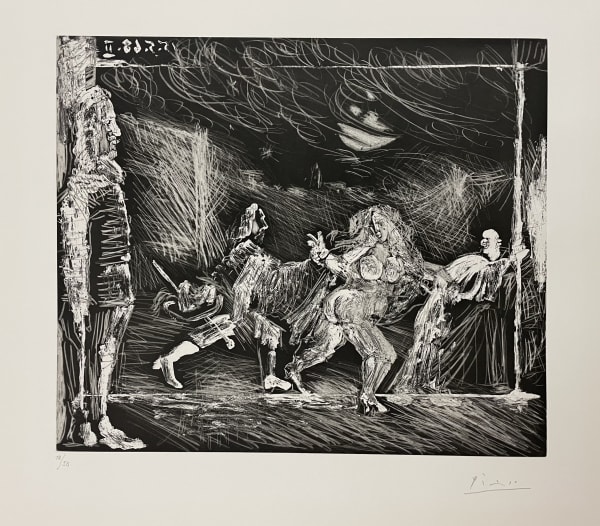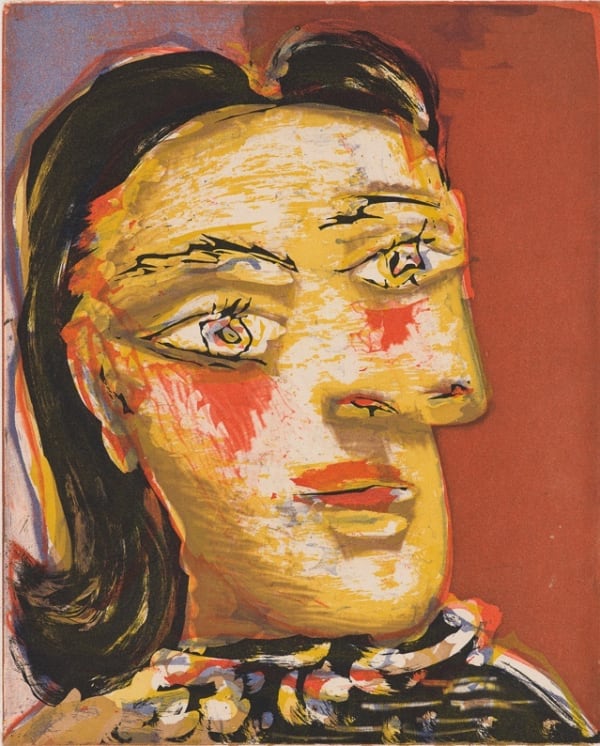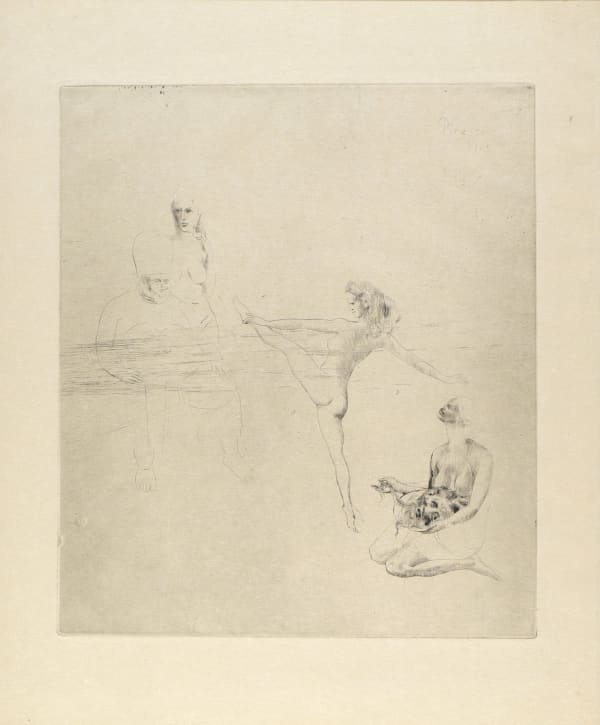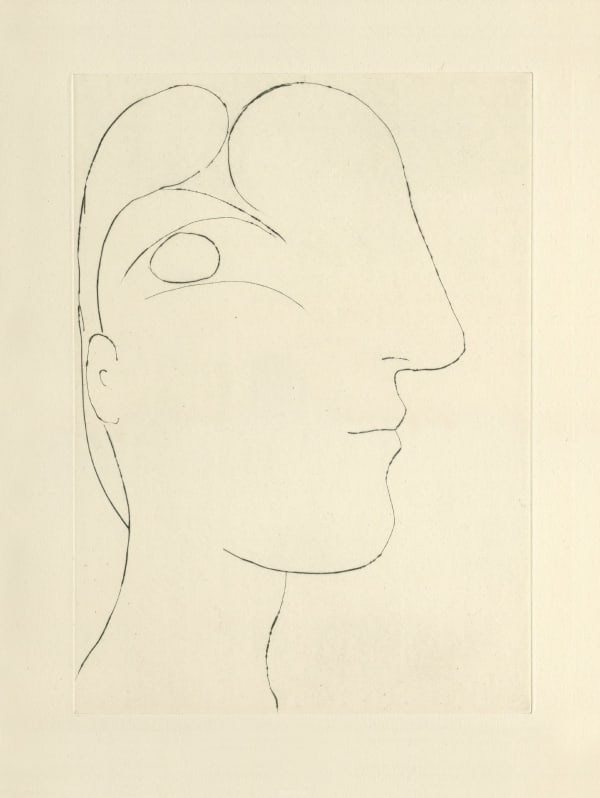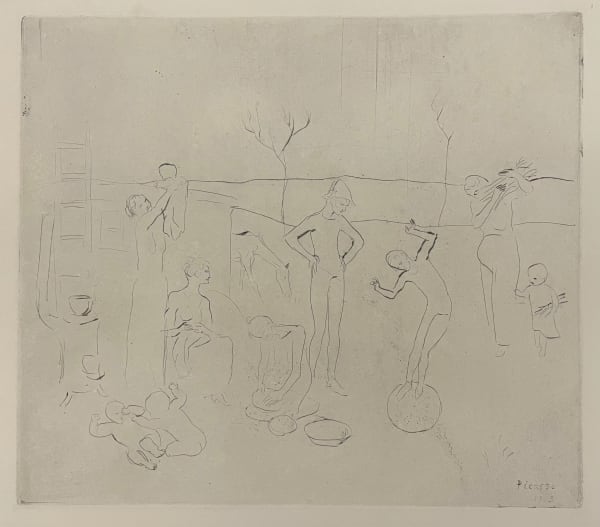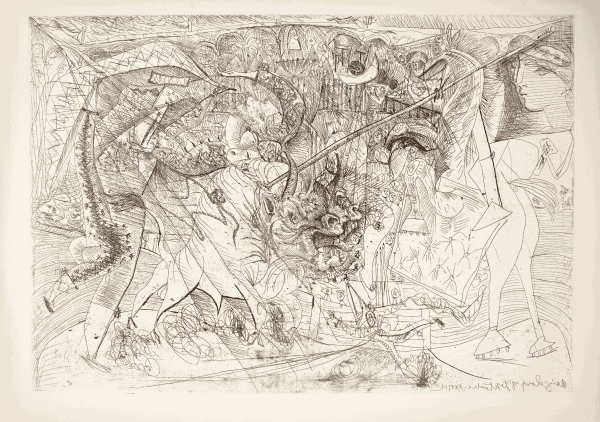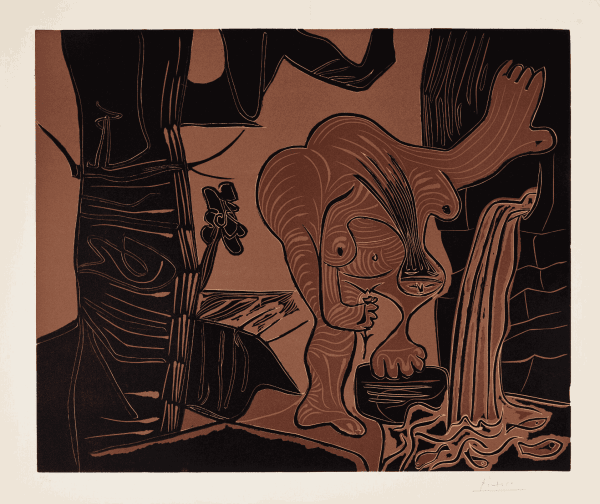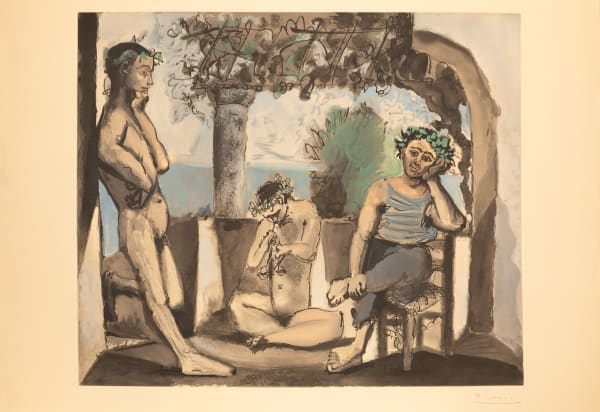Pablo PICASSO: MasterPrints
Pablo Picasso created throughout his career a vast body of graphic work, producing around 2,400 drypoints, aquatints, lithographs and linocuts between 1905 and his death. He practiced and experimented with all etching techniques, often breaking new ground in the artistic field of printmaking. Unlike his contemporaries, such as Miro, Braque or Chagall, from 1930 onwards Picasso's prints took on a life of their own, freeing themselves from his pictorial work.
They represented a catalyst for Picasso's boundless creativity Picasso's boundless creativity, presenting ever-different themes and styles. The artist's work and life are closely intertwined. Each time Picasso embarks on a new love affair - with Fernande Olivier, Olga, Marie-Thérèse, Dora Maar, Françoise Gilot or Jacqueline - a new creative flight and a change of style follow.
A master painter of the 20th century, Pablo Picasso created throughout his career a vast body of graphic work, producing around 2,400 drypoints, aquatints, lithographs and linocuts between 1905 and his death. He practiced and experimented with all etching techniques, often breaking new ground in the artistic field of printmaking.
Unlike his contemporaries, such as Miro, Braque or Chagall, from 1930 onwards Picasso's prints took on a life of their own, freeing themselves from his pictorial work. They represented a catalyst for Picasso's boundless creativity Picasso's boundless creativity, presenting ever-different themes and styles. The artist's work and life are closely intertwined. Each time Picasso embarks on a new love affair - with Fernande Olivier, Olga, Marie-Thérèse, Dora Maar, Françoise Gilot or Jacqueline - a new creative flight and a change of style follow. This metamorphosis of the work is not only superficial, but also thematic.
Always concerned with the history of art and his place in it, Picasso often looked to the masters of the past, both for inspiration and to confront
them. In the artist's great Print Suites, we often find references to the masters of engraving - Rembrandt, Cranach, Goya and Degas.
Picasso was to produce several large series of prints, from the Suite des Saltimbanques, which also opened his collaboration with Ambroise Vollard in
1905, to his magnum opus graphic, the Suite Vollard, to undertake towards the find of his life two great series - the 347 and 156 - a veritable technical tour de force. We should also mention his linocuts which, despite their separate publication, bear witness to a very specific stage in Picasso's life and creation, a moment of return to his Mediterranean roots in the South of France. In each case, the artist collaborated closely with master printers Fréault, Lacourière, Arnera and the Crommelynck brothers.
Located for over a decade next to the Musée Picasso, the Galerie Jean-François Cazeau has played a key role in the discovery of the artist's graphic work, often presented in conjunction with exhibitions. Pablo Picasso: MasterPrints offers a panoramic view of the artist's graphic creations through all his techniques, series and creative periods.
-
 Pablo PicassoThéâtre ou télévision: cape et épée , 1968Aquatint and etching on Rives vellum paperImage: 29.5 x 34.5 cm
Pablo PicassoThéâtre ou télévision: cape et épée , 1968Aquatint and etching on Rives vellum paperImage: 29.5 x 34.5 cm
Sheet: 45.5 x 52 cmN° 18/50
From an edition of 50.
Printed by the Atelier Crommelynck, Paris
Edited by Galerie Louise Leiris, ParisSigned on the lower right corner -
 Pablo PicassoTête de femme n° 5 (Portrait of Dora Maar), 1939-42Aquatint and drypoint in color, on Montval paper watermarked "Vollard".Image: 30 x 23.8 cm (11 3/4 x 9 3/8 in.)
Pablo PicassoTête de femme n° 5 (Portrait of Dora Maar), 1939-42Aquatint and drypoint in color, on Montval paper watermarked "Vollard".Image: 30 x 23.8 cm (11 3/4 x 9 3/8 in.)
Sheet: 44.5 x 34 cm (17 1/2 x 13 3/8 in.)
Framed: 65 x 55 cm (25 5/8 x 21 5/8 in.)One of six impressions pulled without allowing the colors to dry between each run, from the total unsigned edition of 105. The edition was 80 plus 25 artist's proofs. Printed by Lacourière and published by Vollard, Paris. -
 Pablo PicassoTête de femme n° 4 (Portrait of Dora Maar), 1939Aquatint, scraper and drypoint on Montval paper with Vollard watermarkImage: 29.9 x 23.7 cm (11.8 x 9.3 in.)
Pablo PicassoTête de femme n° 4 (Portrait of Dora Maar), 1939Aquatint, scraper and drypoint on Montval paper with Vollard watermarkImage: 29.9 x 23.7 cm (11.8 x 9.3 in.)
Sheet: 45 x 34 cm (17 3/4 x 13 3/8 in.)
Framed: 65.5 x 56 cm (25 3/4 X 22 in.)Numbered in pencil “50/80”. Printed by Lacourière. -
 Pablo PicassoTête de femme n° 2 (Portrait of Dora Maar), 1939Aquatint, scraper and drypoint in four colorsPlate size: 29.9 x 23.7 cm (11 7/8 x 9 3/8 in.)
Pablo PicassoTête de femme n° 2 (Portrait of Dora Maar), 1939Aquatint, scraper and drypoint in four colorsPlate size: 29.9 x 23.7 cm (11 7/8 x 9 3/8 in.)
Framed: 66 x 55 cm (26 x 21 5/8 in.)Aquatint, scraper and drypoint in four colors on four copper plates 104 prints on Montval paper. These proofs are neither numbered nor signed.Dated upper right: 20/4/39 -
 Pablo PicassoTête de femme de profil, 1959Linocut on Arches paper75.2 x 62.2 cm (29 5/8 x 24 1/2 in.)
Pablo PicassoTête de femme de profil, 1959Linocut on Arches paper75.2 x 62.2 cm (29 5/8 x 24 1/2 in.)
98 x 85 cm, framedArtist's ProofSigned "Picasso" on the bottom right, noted "epreuve d'artiste" on the lower left -
 Pablo Picasso, Souvenirs: Cirque, avec El Gigante et autoportrait en bébé-vieillard, 1968
Pablo Picasso, Souvenirs: Cirque, avec El Gigante et autoportrait en bébé-vieillard, 1968 -
 Pablo PicassoSaltimbanque au repos, 1905Drypoint on Van Gelder vellum paper.Image : 12 x 8.5 cm
Pablo PicassoSaltimbanque au repos, 1905Drypoint on Van Gelder vellum paper.Image : 12 x 8.5 cm
Sheet : 33 x 51 cmPrinted by Louis Fort, Paris, and edited in 250 proofs by Ambroise Vollard, Paris. -
 Pablo PicassoSalomé , 1905EtchingImage: 34.8 x 40 cm
Pablo PicassoSalomé , 1905EtchingImage: 34.8 x 40 cm
Sheet: 44.8 x 55 cmOne of 27 proofs printed by Fort with background tinting on old Japon for Ambroise Vollard, before the run of 250 on Van Gelder laid paper.
Unsigned and un-numbered by the hand of the artist.Signed and dated in the plate -
 Pablo PicassoProfil sculptural de Marie-Thérèse, 1933Etching and dry-point on Montval paper, "Picasso" filigree31,8 x 22.8 cm (image)
Pablo PicassoProfil sculptural de Marie-Thérèse, 1933Etching and dry-point on Montval paper, "Picasso" filigree31,8 x 22.8 cm (image)
45 x 34 cm (sheet)Edition of 55, printed by Lacourière, Paris, in 1942. This edition was printed on the same paper as was used for the Vollard Suite.Unsigned -
 Pablo PicassoPeintre et son modèle au collier, 1966Aquatint, etching, scraper and drypointImage: 27.2 x 37.6 cm (10 3/4 x 14 7/8 in.)
Pablo PicassoPeintre et son modèle au collier, 1966Aquatint, etching, scraper and drypointImage: 27.2 x 37.6 cm (10 3/4 x 14 7/8 in.)
Sheet: 41 x 50 cm (16 1/8 x 19 3/4 in.)Numbered on the lower left « 35/50 »Signed by the hand of the artist at the bottom right « Picasso » -
 Pablo Picasso, Minotaure embrassant une femme, 1934
Pablo Picasso, Minotaure embrassant une femme, 1934 -
 Pablo PicassoMinotaure aveugle guidé dans la nuit par une petite fille au pigeon , 1934Etching and drypoint on copper plateImage: 24 x 30 cm
Pablo PicassoMinotaure aveugle guidé dans la nuit par une petite fille au pigeon , 1934Etching and drypoint on copper plateImage: 24 x 30 cm
Papier: 34 x 43.7 cmEdition of 260 on Montval paper, filigree "Picasso".
Printed by Lacourière, Paris.
Edited by Ambroise Vollard, Paris.Signed by the artist on the lower-right corner -
 Pablo Picasso, Mère et enfant au fichu, 1966
Pablo Picasso, Mère et enfant au fichu, 1966 -
 Pablo Picasso, Maison close. Médisances. Avec profil de Degas au nez foncé, 1971
Pablo Picasso, Maison close. Médisances. Avec profil de Degas au nez foncé, 1971 -
 Pablo PicassoLes Saltimbanques, 1905Etching on Van Gelder vellum paper28.8 x 33 cmEdition à 250 exemplaires, Editée par Ambroise Vollard.
Pablo PicassoLes Saltimbanques, 1905Etching on Van Gelder vellum paper28.8 x 33 cmEdition à 250 exemplaires, Editée par Ambroise Vollard.
Imprimée par Louis Fort, Paris
Filigrane VollardSigned and dated on the plate -
 Pablo PicassoLes Ménines, 1959Dessin aux crayons de couleur32 x 24 cmSigné au crayon "Picasso", daté "le 28.1.59"
Pablo PicassoLes Ménines, 1959Dessin aux crayons de couleur32 x 24 cmSigné au crayon "Picasso", daté "le 28.1.59" -
 Pablo PicassoLe Papillon, 1936-1942Sugar-lift Aquatint, scraper and dry point on Imperial Japanese paper.37 × 27 cm (14 ½ x 10 5/8 in.)
Pablo PicassoLe Papillon, 1936-1942Sugar-lift Aquatint, scraper and dry point on Imperial Japanese paper.37 × 27 cm (14 ½ x 10 5/8 in.)
Framed: 62 x 53 cm (24 ½ x 21 in.)One of the rare titled 35 prints on Imperial Japanese paper.
Print Roger Lacourière workshop, Paris. -
 Pablo PicassoLe Faune, 1962Linocut printed on Arches paperImage : 64 x 52.8 cm (25 3/8 x 20 3/4 in.)
Pablo PicassoLe Faune, 1962Linocut printed on Arches paperImage : 64 x 52.8 cm (25 3/8 x 20 3/4 in.)
Sheet : 75.2 x 62 cm (29 3/8 x 24 3/8 in.)
Framed : 103.5 x 91 cmN° 43/50
Printed by Arnèra (Vallauris)Signed « Picasso » on the lower right in pencil and numbered «43/50 » on the bottom right. -
 Pablo PicassoLe Bélier, 1936-1942Sugar-lift Aquatint, scraper and dry point on Imperial Japanese paper.37 x 27 cm (14 ½ x 10 5/8 in.)
Pablo PicassoLe Bélier, 1936-1942Sugar-lift Aquatint, scraper and dry point on Imperial Japanese paper.37 x 27 cm (14 ½ x 10 5/8 in.)
Framed: 62 x 53 cm (24 ½ x 21 in.)One of the rare titled 35 prints on Imperial Japanese paper.
Print Roger Lacourière workshop, Paris. -
 Pablo PicassoLa Puce, 1936 - 1942Etching and aquatint on Chinese paper37 x 27 cm (14 ½ x 10 5/8 in.)2nd state B, Artist proof on Chinese paper, aside from the numbered edition of 35 original etchings to illustrate Buffon’s texts, Paris, 1942.
Pablo PicassoLa Puce, 1936 - 1942Etching and aquatint on Chinese paper37 x 27 cm (14 ½ x 10 5/8 in.)2nd state B, Artist proof on Chinese paper, aside from the numbered edition of 35 original etchings to illustrate Buffon’s texts, Paris, 1942.
Martin Fabiani, editor. Proof printed by Lacourière. -
 Pablo PicassoLa Grande Corrida, 1934Etching on copper-plate, on Montval "vergé" paper.Image: 48.7 x 69.7 cm
Pablo PicassoLa Grande Corrida, 1934Etching on copper-plate, on Montval "vergé" paper.Image: 48.7 x 69.7 cm
Sheet: 56.8 x 77.5 cmEdition of 50.
The edition, planned by Vollard at 50 examples, was never delivered or paid for due to the death of the great Parisian dealer. The proofs were bought in 1960 by a Parisian dealer. Only a few (four or five) prints, sold by Lacourière, were signed by Picasso.Non-signed -
 Pablo Picasso, La Chèvre, 1952
Pablo Picasso, La Chèvre, 1952 -
 Pablo PicassoHomme au Bâton/Le Vieux Bouffon, 1963Linocut, printed in color on Arches paperImage: 64 x 53.6 cm (25 ¼ x 21 1/8 in.)
Pablo PicassoHomme au Bâton/Le Vieux Bouffon, 1963Linocut, printed in color on Arches paperImage: 64 x 53.6 cm (25 ¼ x 21 1/8 in.)
Sheet: 75.2 x 62.5 cm (29 5/8 x 24 5/8 in.)
Framed: 100 x 91 cm (39 3/8 x 35 7/8 in.)One of a rare few artist proofs
Printed by Arnèra (Vallauris)Signed « Picasso » on the lower right in pencil -
 Pablo PicassoFemme Torero I, 1934Etching on copper-plate printed on Montval "vergé" paper.Image: 49.7 x 69.7 cm
Pablo PicassoFemme Torero I, 1934Etching on copper-plate printed on Montval "vergé" paper.Image: 49.7 x 69.7 cm
Sheet: 57.1 x 77.5 cmEdition of 50.
The edition, of which Vollard planned 50 proofs, was never delivered or paid for due to the death of the great Parisian art dealer. Only a few (four or five) proofs, sold by Lacourière, were signed by Picasso.Unsigned. -
 Pablo Picasso, Femme nue devant une statue, 1931
Pablo Picasso, Femme nue devant une statue, 1931 -
 Pablo PicassoFemme nue à a source, 1963Linocut in colours on Arches vellum paperImage: 53.4 x 64 cm
Pablo PicassoFemme nue à a source, 1963Linocut in colours on Arches vellum paperImage: 53.4 x 64 cm
Sheet: 62.5 x 75.5 cmEdition of 50, n°48/50 Printed by Arnera, vallaurisEdited by Louise Leiris, ParisSigned on the lower right cornr and numbered by the artist -
 Pablo PicassoFemme assise en tailleur: Geneviève Laporte, 1951Etching and drypoint on Japon nacre paperImage: 14.4 x 10 cm (5 3/4 x 3 7/8 in.)
Pablo PicassoFemme assise en tailleur: Geneviève Laporte, 1951Etching and drypoint on Japon nacre paperImage: 14.4 x 10 cm (5 3/4 x 3 7/8 in.)
Sheet: 30.8 x 23.2 cm (12 1/8 X 9 1/8 in.)Numbered in pencil, " 156/180 ", on the lower left.
There were 12 artist's proofs.
Published by B. Gili, Barcelona.Signed on the lower right in pencil, "Picasso" -
 Pablo PicassoBacchanale, 1955Eau-forte et aquatinte en couleurs sur vélin de RivesImage: 47, 4 x 56,3 cm
Pablo PicassoBacchanale, 1955Eau-forte et aquatinte en couleurs sur vélin de RivesImage: 47, 4 x 56,3 cm
Feuille: 56 x 76,5 cmEdité par Crommelynck, Paris.
Une des rares épreuves d’artistes signées, réservées à Picasso, à l’imprimeur et à l’éditeur, à part de l’édition à 300 exemplaires numérotés et signés.Signé au crayon en bas à droite -
 Pablo Picasso, Au Bain, 1930
Pablo Picasso, Au Bain, 1930

